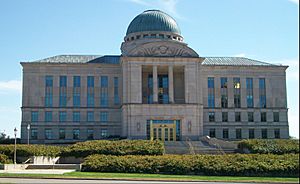Iowa Supreme Court facts for kids
The Iowa Supreme Court is the highest court in the U.S. state of Iowa. The Court has seven judges – called "justices" – on it: a Chief Justice and six Associate Justices. The Court normally meets in Des Moines in the Iowa Judicial Branch Building.
The Court
In 1846, Iowa was the 29th state to join the United States. Iowa's government is similar to the federal government of the United States. The government of Iowa has three branches: the legislative branch (the Iowa General Assembly), the executive branch (the Governor of Iowa), and the judicial branch (the Iowa Supreme Court).
The Iowa Supreme Court is an appellate court. An appellate court does not have trials, but reviews the decisions of other state courts. The Court does many things:
- It is the highest court in the Iowa state court system. Its decisions are binding on all other Iowa state courts. If a case is about federal law, the Supreme Court of the United States may review the Iowa Supreme Court's decision in the case.
- It licenses lawyers to practice law in Iowa, makes the rules lawyers have to follow, and can warn lawyers or take away their license to practice if they break the rules.
- It makes the rules for the Iowa state courts.
- It is in charge of the judicial branch and judicial officers and court employees.
Justices
Justices are appointed – chosen – by the governor from a list of three people chosen by the State Judicial Nominating Commission. A new justice serves a one-year term after appointment and until January 1 after the next judicial retention election. After the election, a justice serves an eight-year term. At the end of a justice's term, there is a retention election – an election to decide if the justice gets another term. A justice must retire at the age of 72. The justices elect the chief justice.
| Name | Term begins | Term ends | Appointing Governor | Governor's Party |
|---|---|---|---|---|
| Chief Justice Mark Cady | 1998 | December 31, 2016 | Terry Branstad | Republican |
| David Wiggins | 2003 | December 31, 2012 | Tom Vilsack | Democratic |
| Daryl Hecht | 2006 | December 31, 2016 | Tom Vilsack | Democratic |
| Brent Appel | 2006 | December 31, 2016 | Tom Vilsack | Democratic |
| Bruce Zager | February 2011 | December 2012 | Terry Branstad | Republican |
| Edward Mansfield | February 2011 | December 2012 | Terry Branstad | Republican |
| Thomas Waterman | February 2011 | December 2012 | Terry Branstad | Republican |
The Chief Justice and two other justices, were not elected in the November 2, 2010 retention election. Governor Branstad appointed Edward Mansfield, Thomas D. Waterman, and Bruce Zager to replace them in February 2011. While waiting for the new justices, the Court chose Justice Cady as the new Chief Justice. In March 2011, the new Court voted for Justice Cady to stay as Chief Justice. There will be a retention election for the new justices in November 2012.


